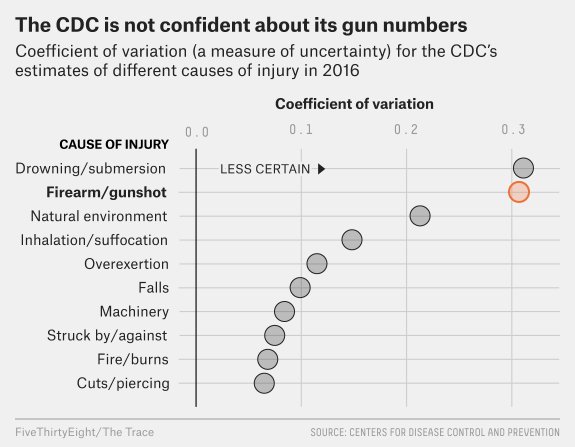A lot of brouhaha in the #gunviolence world about this well-reported article showing that @CDCgov data on the number of NON-FATAL gun injuries is not accurate. fivethirtyeight.com/features/the-c…
I want to highlight a few things about this article.
I want to highlight a few things about this article.
1. First, kudos to the writers for highlighting an issue that all of us #gunviolence researchers bemoan: that there are NO GOOD SOURCES OF DATA on non-fatal gun injuries. As the article reports, even the CDC admits that its data on #gunviolence injuries are unreliable. 

2. Please note that this issue is not unique to #gunviolence non-fatal injuries. It’s also observed for other types of injuries (like drownings).
It’s because of the way that the CDC is forced to collect non-fatal-injury data.
It’s because of the way that the CDC is forced to collect non-fatal-injury data.
3. Although the reliability of the CDC data on #gunviolence is low, overall the numbers for CDC estimates are “tighter” than the numbers from other sources of #gunviolence injury data, which range tremendously.
4.And – the estimates for #s of injuries from CDC are pretty darn similar to the estimates from other data sources. (For all we know, prior years’ CDC numbers were *under*estimates? Who knows!) 

5 BUT!!!!! BUT!!!! BUT!!!!
Lost in the article is this important fact: regardless of the debate about number of #gunviolence INJURIES, gun DEATHS are INDISBUTABLY high in the US. There is zero debate about this fact.
Here is some data to support that assertion:
Lost in the article is this important fact: regardless of the debate about number of #gunviolence INJURIES, gun DEATHS are INDISBUTABLY high in the US. There is zero debate about this fact.
Here is some data to support that assertion:
6. To quote from a recent article on youth mortality in the US: "The firearm-homicide rate among individuals aged 15 to 29 years was 82x higher in the US than 19 other high-income countries and increased by about 25% between 2012 to 2014." ja.ma/2CzwXz4
7. #gunviolence homicide is mostly affecting young minority males. But according to the same JAMA article, the US youth firearm #suicide rate is 8x higher than in similar high-income countries. This rate is also increasing, especially for white kids.
8. Another recent article in JAMA ja.ma/2IHWmqF reports (using global death data) that rates of firearm injury and death in the US is similar to that of Venezuela or Colombia.
9. According to the analyses presented in this article, the rate of #gunviolence deaths decreased in the late 90s (due to the end of the crack epidemic), but is now rising again.
10.Yet another article in JAMA reports that the fatality **RATE** from #gunviolence injuries is increasing in Denver -- in other words, people who are shot are MORE LIKELY to die. ja.ma/2Cuazad
11. (This same article reports a DECREASING fatality rate for every other type of injury. So: something is different about gun injuries. It's not the fault of the trauma system, it's the fault of the injury itself.)
12. Of course, none of these studies report on the very real #mentalhealth effects of #gunviolence exposure. (That’s a whole different thread… stay tuned.)
13. In sum: I’m super super happy that @teamtrace and @FiveThirtyEight are calling out the very real issue of unreliability of #gunviolence injury data.
But I don’t want this critique to lead to us throwing the baby out with the bathwater.
But I don’t want this critique to lead to us throwing the baby out with the bathwater.
14. What they are ultimately proving is that “We have a lost generation of firearms research" (per the ever-eloquent @sandrogalea) --- due to restrictions on @CDCgov (& NIH) data collection, analysis, and extramural funding. 

15. TL/DR? --> The takeaways:
a.#gunviolence is a #publichealth problem.
b.WE NEED BETTER DATA - which is the basis of the #publichealth approach.
c. We need FUNDING to make this happen.
a.#gunviolence is a #publichealth problem.
b.WE NEED BETTER DATA - which is the basis of the #publichealth approach.
c. We need FUNDING to make this happen.
Kudos @researchaffirm @strohcunningham @wycdinitiative & many others for being part of the solution.
Because if others won’t do it, we will. #docs4gunsense
Because if others won’t do it, we will. #docs4gunsense
Thank you @njoshi8 @darakass @choo_ek @physicianwomen @JuddHollander @ReginaRoyan @traependergrast @StuckonSW @RobinCogan @hshermd @JosephSakran @AbbieYoukilis @GitaPensaMD & many more, for being part of the solution too :)
and: @EmmyBetz @vickachaplin @peter_masiakos @ChanaSacks @scrubbedin @laurie_punch @dakuhls @Stewartr84 @emresidents @ACEPNow @AmerMedicalAssn @AmCollSurgeons @AmerAcadPeds @jbm2033 ....
• • •
Missing some Tweet in this thread? You can try to
force a refresh




